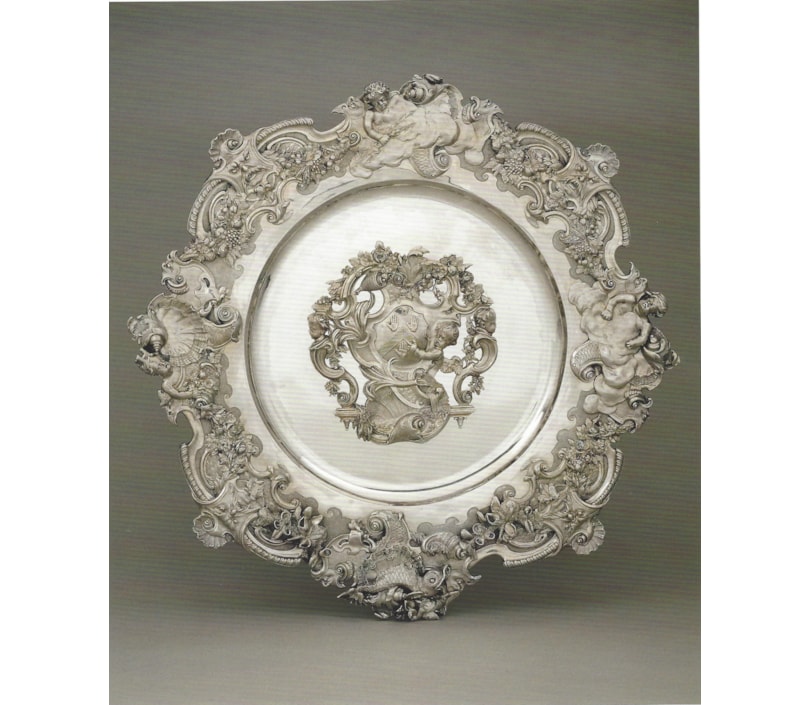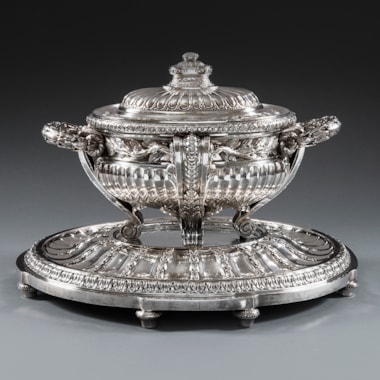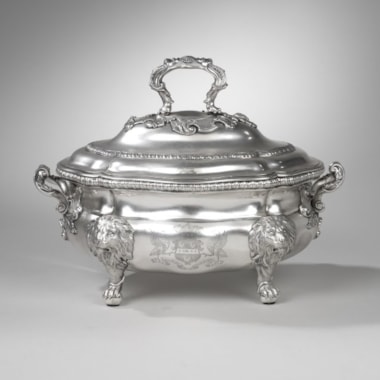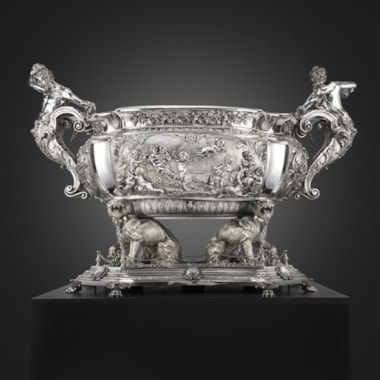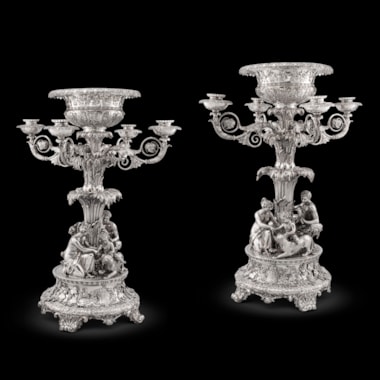The circular dish has a shallow well, a broad rim, and a shaped outline. The border has cast and chased ornament representing the four elements alternating with grotesque masks emerging from gadrooned pediments. A putto representing Fire carries a lightning bolt, another representing Air, his hair wind- swept, emerges from a cloud. A cluster of shells and a fanciful fish at the base represent Water and a putto wearing a crown in the form wider of a battlement and carrying a floral garland that represents Earth.
Armorials And Inscriptions: At centre of dish, the arms of Maynard with a crescent for difference probably for one of the sons of Banastre, 3rd Baron Maynard, probably, Grey 5th Baron Maynard (I679-1745); scratched on back of dish: 247-7; pounced 50
This dish, cast with the arms of Maynard in the cartouche at the centre, is a key work of rococo silver. The lively figural border, with figures emerging from richly chased natural settings and broken cartouches, is the earliest appearance of an influential artistic personality, who has been called some scholars the "Maynard Master after this dish.
For all its stylistic importance, the patron for whom it was made remains an enigmatic figure. The arms (argent, a chevron azure, between three sinister hands gules) are shown without a coronet and are differenced by a crescent to indicate that they belong to the next in line for the title. In 17 36, the year the dish was marked, the crescent would have been used by Grey Maynard, whose older brother Henry was 4th Baron until his death in 1742. If Grey Maynard was a stylish figure in court society, or if he was an innovative patron of the arts, the evidence of it is largely lost, with the exception of his purchases from Paul de Lamerie. A Tory he seems not to have run for public office, although he held two positions at court: he served as Yeoman of the Standing Wardrobe from 1710, and as Yeoman of the Removing Wardrobe from 1728 until 1741. The Office of the Removing Wardrobe was one of many court positions created by Charles II in I660, and it was eventually abolished in 1782. In 1734 he is mentioned in the Day Book of the Royal Goldsmiths having ordered a set of chapel plate "for the use of her Roy. Highness the Princess Royalls Chapel.'' As Yeomen, Grey Maynard received an annual salary of £230, and the Lord Chamberlain’s accounts record that he was paid "for washing sheets etc” Presumably his responsibilities involved oversight of some of the private rooms at the royal residences, not the laundry itself, but it is hard to square what we know about Grey Maynard with his patronage of de Lamerie. Easton Lodge, his family's estate near Dunmow in Essex, was granted in 1589 to his ancestor Henry Maynard, Secretary to Lord Burghley. The late Elizabethan house was depicted in 1768 (fig. 27-8), but it burned in 1847 and again in 1918, so any redecoration instituted by Grey Maynard has not survived. He never married, and in 1745 he died in his London house Grosvenor Square, having made accommodations in his will for members of his family as well as Elizabeth Humphreys, the "widow in whose house I lived several years in Chancery Lane and who, since the illness I had since the death of my brother, and have since been often seized with, has given her time entirely to attend upon me." The balance of his estate he left to his younger brother, Cha who became 6th Baron Maynard. He was not one of de Lamerie's politically visible patrons, like Lord Hardwicke, nor was he a subject of gossip or admiration at court
Notwithstanding a lack of contextual evidence, G Maynard seems to have been a significant customer of de Lamerie. In 1736, along with this sideboard dish, he bought a salver, in the Cahn collection, and a set of four waiters with fluted, rococo borders, and engraved arms at the centre. In 1737 he bought another stylistically innovative piece, the cup with serpent handles and abstract grotesques, now in the Worshipful Company of Fishmongers. A basket of fairly conventional design was added in 1743 and the following year he bought a set of candlesticks, now at the Ashmolean Museum. We do not know what percentage these pieces represent of Grey Maynard's total purchases from de Lamerie. It is a reminder that in our study of de Lamerie's patrons, the accidental survival of documents and of silver can skew our assessment.
It is the inventive, sculptural border, broken rhythmically with figural scenes, that establishes a place for the Maynard Dish at the top of de Lamerie's oeuvre. The delicately worked surface, with its fluid, nuanced chasing further expresses the complex composition, a rare instance when we can surmise that the same artist rendered the model for the cast components and executed the final chasing. Ubaldo Vitali has proposed that this individual was mainly a chaser, who would have worked the models for the applied plaques and central cartouche in metal, probably copper. He would doubtless have also used wax or wood when called for in various works, but it is as a chaser that his abilities as an artist are most evident. The discovery of five drawings by his hand in Dresden sheds new light on his artistic sensibilities and method of working.
S.F. Kennedy before I901; Crichton Brothers, London, before 1935; Duveen Brothers, 1950; Mrs. Fay Plohn, sold Sotheby's, London, July 16, lot I45; Estate of Hilmar Recksten, sold Christie's, London, May 22, 1991, lot I45 private collection, London purchased 1996, Koopman Rare Art, London
Phillips, p. 98, pl. 104; Hernmarck, no. 688, p. 256; Brett, no. 710, p. 174; Hare, p. 22
You May Also Like



































































